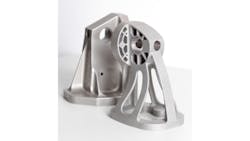Investment Casting vs. Additive Manufacturing in Airbus Study
Airbus Group Innovations — the jet builder’s network of technology centers that research technologies and develop products — recently worked with an Additive Manufacturing (AM) process developer on an environmental lifecycle comparison of two critical production technologies. Working with EOS, the center in Filton, England, evaluated both rapid investment casting and direct metal laser sintering (DMLS) for a standard Airbus structural part, including detailed aspects of the overall lifecycle.
EOS is a developer of AM/industrial 3D printing processes, including system technology, software, materials, material development, and other services.
DMLS is a process that converts a CAD design of a part into .stl file format. This information is read as “layers” by a 3D printer, which deposits metal powders and fuses each success layer to the previous one using a fiber-optic laser, depositing layer after layer of the fused metal to recreate the design in three dimensions.
The eco-assessment involved an Airbus A320 nacelle hinge bracket. Researchers studied the product development from the supplier of the raw material, to the equipment manufacturer (EOS), and the end-user (Airbus.) Adapted from Airbus’ streamlined lifecycle assessment (SLCA) and ISO 14040 series requirements data, the testing program will be the basis for continued “cradle-to-cradle” studies into other aerospace parts, processes, and end-of-life strategies, according to EOS
Two Phase Assessments
The first step involved a SLCA a generic bracket to benchmark the DMLS process versus a conventional casting process. With this as a baseline, the researchers compared the lifecycle of a conventionally cast steel bracket with that of a design-optimized titanium bracket (DMLS). Among their determinations:
• The use phase has the greatest impact in terms of energy consumption and CO2 emissions over the whole lifecycle of the bracket.
• CO2 emissions over the lifecycle of the nacelle hinges were reduced by nearly 40% thanks to weight savings resulting from optimized geometry, which is possible thanks to the design flexibility offered by DMLS and by using titanium.
• Most significant, using DMLS to build the hinge may reduce the weight per plane by 10 kilograms — a considerable savings for aircraft OEM’s “buy-to-fly” ratios.
The second phase of the analysis focused on manufacturing a design-optimized, titanium bracket. This comparison pitted an investment casting process versus DMLS with the EOSINT M 280 system. Among these conclusions:
• Total energy consumed creating the powder metal, then producing the bracket in DMLS, was less than the equivalent steps of an investment casting process; the high energy use of DMLS is limited to the melt and chill cycle of its manufacturing profile, and offset by a reduced build time.
Comparatively, investment casting involved the energy consumed to produce an epoxy model via stereolithography (SLA), followed by the furnace operation to produce the casting mold from the model and the finished casting, all of which uses high volumes of energy and generates greenhouse gases.
· The DMLS process used only the material actually needed to make the part — thus eliminating finish machining and reducing consumption of titanium by 25% versus the investment casting route.
“DMLS has demonstrated a number of benefits, as it can support the optimization of design and enable subsequent manufacture in low-volume production,” reported Jon Meyer, Additive Layer Manufacturing Research Team Leader, in the final report. “In general, the joint study revealed that DMLS has the potential to build light, sustainable parts with due regard for the company’s CO2 footprint.”
Nicola Knoch, environmental and sustainability consultant to EOS, said the research effort established “a valuable, holistic baseline” for measuring costs, benefits, and impacts of DMLS.
About the Author
Robert Brooks
Content Director
Robert Brooks has been a business-to-business reporter, writer, editor, and columnist for more than 20 years, specializing in the primary metal and basic manufacturing industries. His work has covered a wide range of topics, including process technology, resource development, material selection, product design, workforce development, and industrial market strategies, among others.
